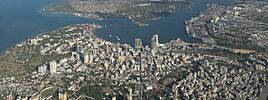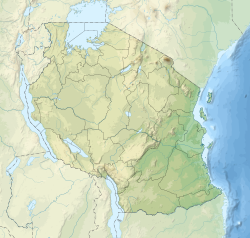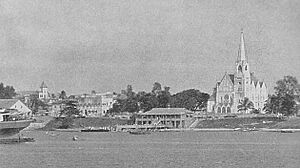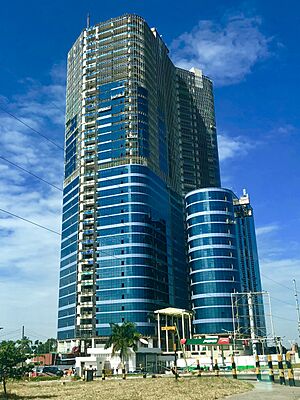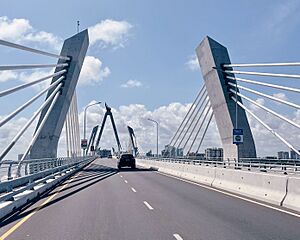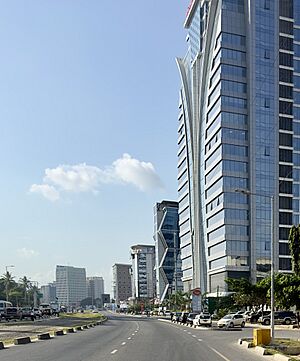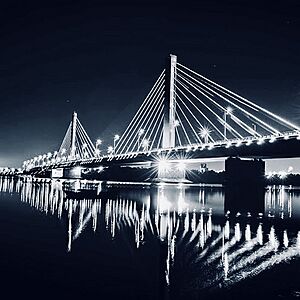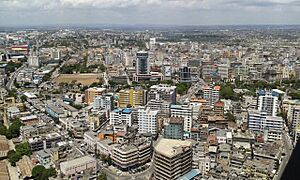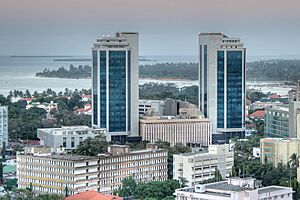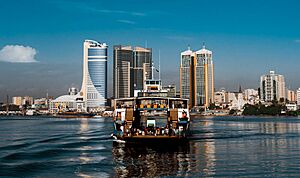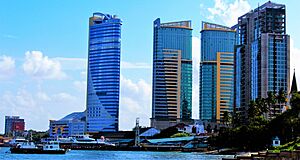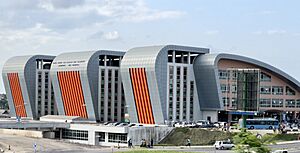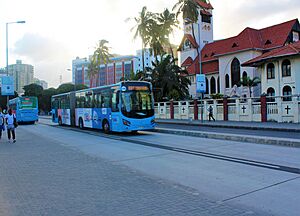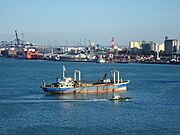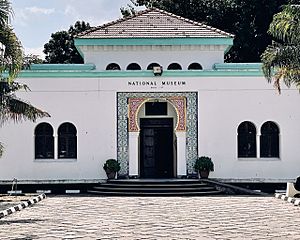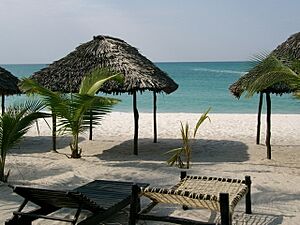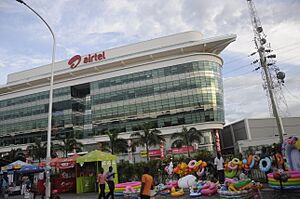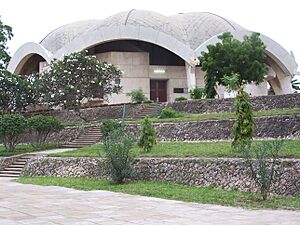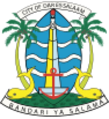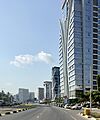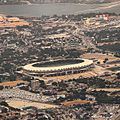Dar es Salaam facts for kids
Quick facts for kids
Dar es Salaam
Dar
|
||
|---|---|---|
|
Aerial view of Dar es Salaam
St. Joseph's Cathedral
Askari Monument
Mohammed VI Mosque
Tanzania National Stadium
Aerial view of Dar es Salaam Port
Skyline from MV Kigamboni
|
||
|
||
| Country | ||
| Zone | Coastal Indian Ocean | |
| Districts |
List
Ilala
Kigamboni Kinondoni Ubungo Temeke |
|
| Area | ||
| • Total | 1,493 km2 (576 sq mi) | |
| • Water | 0 km2 (0 sq mi) | |
| Population
(2022 census)
|
||
| • Total | 5,383,728 | |
| • Density | 3,606.0/km2 (9,339.4/sq mi) | |
| Time zone | UTC+3 (EAT) | |
| Postcode |
11xxx
|
|
| Area code(s) | 022 | |
| HDI (2018) | 0.699 medium · 2nd |
|
Dar es Salaam (which means "Abode of Peace" in Arabic) is the biggest city and a major business center in Tanzania. It is also the capital of the Dar es Salaam Region. With over five million people, Dar es Salaam is the largest city in East Africa and the sixth-largest in all of Africa.
This important city is located on the Swahili coast. It was founded around 1865 by Majid bin Said, who was the first Sultan of Zanzibar. Dar es Salaam served as the main administrative and business center for different governments over the years, including German East Africa and Tanganyika. Even though the official capital of Tanzania moved to Dodoma in 1996, Dar es Salaam still holds many government offices and is a very important city.
Dar es Salaam is a hub for arts, fashion, media, film, and finance in Tanzania. It is divided into five main areas called districts: Kinondoni, Ilala, Ubungo, Temeke, and Kigamboni.
Contents
- History of Dar es Salaam
- Where is Dar es Salaam?
- Population of Dar es Salaam
- Economy and Business in Dar es Salaam
- Transportation in Dar es Salaam
- Culture in Dar es Salaam
- Places of Worship
- Sports in Dar es Salaam
- Media in Dar es Salaam
- Environment and Flooding
- Education in Dar es Salaam
- Notable People from Dar es Salaam
- Sister Cities
- Images for kids
- See also
History of Dar es Salaam
In the 1800s, there was a small fishing village called Mzizima (meaning "healthy town" in Swahili) on the coast. It was part of the busy Indian Ocean trade routes. In 1865 or 1866, Sultan Majid bin Said of Zanzibar started building a new city nearby. He named it Dar es Salaam, which means "abode of peace."
After Sultan Majid died in 1870, the city became less important for a while. But in 1887, the German East Africa Company set up a station there, and Dar es Salaam began to grow again. It became the main center for German East Africa. The city grew even more when the Central Railway Line was built in the early 1900s.
During World War I, British forces took control of German East Africa. The British Navy attacked the city in 1916. German authorities gave up the city in September 1916. German East Africa then became the British Tanganyika Territory.
Dar es Salaam remained the main administrative and business center. Under British rule, different areas of the city developed separately. For example, European areas like Oyster Bay and African areas like Kariakoo and Ilala grew apart. Many workers from British India also came to the city for trade opportunities. After World War II, Dar es Salaam grew very quickly.
Tanganyika became independent from colonial rule in December 1961. Dar es Salaam stayed its capital. Even when Tanganyika and People's Republic of Zanzibar joined to form Tanzania in 1964, Dar es Salaam remained the capital. However, in 1973, a plan was made to move the capital to Dodoma, a city more in the center of the country. This move was completed in 1996, but Dar es Salaam still has most government offices.
By the 2000s, Dar es Salaam started to grow much faster. Many new businesses opened, and there was a lot of construction, with new tall buildings, bridges, and roads. The city's port is very important for trade with countries like Rwanda, Burundi, Zambia, and parts of the Democratic Republic of the Congo. The city's skyline now features tall buildings, like the PSPF Tower and the Tanzania Ports Authority (TPA) Tower, which is the tallest in the country.
Many old buildings and parts of the city's original layout from colonial times still exist. The Old Boma, built in 1866-67, is one of the city's oldest buildings. The Botanical Gardens are now near the National Museum of Tanzania. The State House also dates back to Sultan Majid bin Said's time. Other historical buildings include the Azania Front Lutheran Church, the Roman Catholic St. Joseph's Cathedral, and Ocean Road Hospital.
Where is Dar es Salaam?
Dar es Salaam is located on the coast of East Africa, at 6°48' S, 39°17' E. It has a natural harbor and sandy beaches in some areas.
Districts of Dar es Salaam
The Dar es Salaam Region is split into five administrative districts. Each district has its own local council.
| District | Population (2016) |
Area (km2) |
|---|---|---|
| Ilala District | 1,528,489 | 210 |
| Kigamboni District | 1,510,129 | N/A |
| Kinondoni District | 1,164,177 | 527 |
| Temeke District | 204,029 | 656 |
| Ubungo District | 1,058,597 | N/A |
| Dar es Salaam Region | 5,465,420 | 1,393 |
Kinondoni District
Kinondoni is the most populated district. Many people live here, including in some wealthy areas.
- Masaki, Oyster Bay, and Ada Estate are high-income areas along the beach. In the past, these were where Europeans lived. Today, many diplomats and people from other countries live here. Oyster Bay Beach (also called Coco Beach) is a popular white sandy beach.
- Mikocheni and Regent Estate are also suburbs in this district. These are middle to high-income areas.
- Msasani is a peninsula northeast of the city center. Many people from the United Kingdom and other Western countries live here. It has a mix of traditional shops and modern resorts.
- Mbezi Beach is a beachfront area with tourist hotels and homes.
- Sinza, Kijitonyama, Magomeni, Kinondoni, and Mwenge are more mixed areas, located west of the city's main business district.
Ilala District
The Ilala district holds most government offices and the main business area. It is also the city's transport hub. The Julius Nyerere International Airport, the Central Railway Station, and the Tazara Railway Station are all here. The homes in this area are mainly for middle to high-income residents.
- Upanga and Kisutu have the largest number of Asian communities, including people of Indian and Arabic descent. These areas have old colonial houses built in Indian, Arabic, and European styles.
- Kariakoo is the city's shopping district. You can find everything from food to hardware in its shops and markets. The Kariakoo Market is a major place where food for Dar es Salaam residents is supplied.
- Tabata, Segerea, and Ukonga are a bit further west from the city center.
- Ilala is a middle-income area close to the city center, known for the Askari Monument.
Temeke District
Temeke is the main industrial district, where many factories are located. The Port of Dar es Salaam, the country's largest port, is also here. Temeke is thought to have the most low-income residents because of the industries. Many military and police officers, as well as port workers, live here.
- Kurasini, located by the harbor, includes the Dar es Salaam Port, the Police College, and the Dar es Salaam International Trade Fair grounds.
- Chang'ombe is one of the few higher-income areas in Temeke. It has the Dar es Salaam University College of Education, the National Stadium, and Uhuru Stadium.
- Temeke, Mtoni, Tandika, Kijichi, and Mbagala are middle to low-income areas. Mbagala is the largest suburb in the district.
Ubungo District
The Ubungo terminal is a major transport link for many parts of Dar es Salaam. A train line runs from here to the city center.
This district has many important social and economic places, like the Urafiki textile industry, the main bus station, and various schools and universities, such as the National Institute of Transport (NIT).
Kigamboni District
Kigamboni (also called South Beach) is a beachfront area on a peninsula. People from different economic backgrounds live here. You can mainly reach this area by ferry, but the Kigamboni Bridge also provides a way to get there.
Climate in Dar es Salaam
Dar es Salaam has a tropical climate. This means it's hot and humid for most of the year because it's close to the equator and the warm Indian Ocean. It has a tropical savanna climate. The city gets about 1,150 millimetres or 45 inches of rain each year. There are usually two rainy seasons: the "long rains" in April and May, and the "short rains" in November and December.
| Climate data for Dar es Salaam (Julius Nyerere International Airport) 1991–2020 | |||||||||||||
|---|---|---|---|---|---|---|---|---|---|---|---|---|---|
| Month | Jan | Feb | Mar | Apr | May | Jun | Jul | Aug | Sep | Oct | Nov | Dec | Year |
| Record high °C (°F) | 35.0 (95.0) |
35.2 (95.4) |
35.0 (95.0) |
35.0 (95.0) |
32.9 (91.2) |
33.0 (91.4) |
31.8 (89.2) |
31.9 (89.4) |
33.8 (92.8) |
33.7 (92.7) |
34.0 (93.2) |
34.5 (94.1) |
35.2 (95.4) |
| Mean daily maximum °C (°F) | 32.4 (90.3) |
32.8 (91.0) |
32.4 (90.3) |
31.1 (88.0) |
30.3 (86.5) |
30.0 (86.0) |
29.7 (85.5) |
30.1 (86.2) |
30.8 (87.4) |
31.5 (88.7) |
31.7 (89.1) |
32.1 (89.8) |
31.2 (88.2) |
| Daily mean °C (°F) | 28.6 (83.5) |
28.6 (83.5) |
28.2 (82.8) |
27.1 (80.8) |
26.1 (79.0) |
25.1 (77.2) |
24.4 (75.9) |
24.5 (76.1) |
25.1 (77.2) |
26.2 (79.2) |
27.2 (81.0) |
28.3 (82.9) |
26.6 (79.9) |
| Mean daily minimum °C (°F) | 24.9 (76.8) |
24.5 (76.1) |
24.0 (75.2) |
23.2 (73.8) |
22.0 (71.6) |
20.3 (68.5) |
19.3 (66.7) |
19.1 (66.4) |
19.5 (67.1) |
20.8 (69.4) |
22.6 (72.7) |
24.2 (75.6) |
22.0 (71.6) |
| Record low °C (°F) | 18.1 (64.6) |
18.4 (65.1) |
19.6 (67.3) |
19.6 (67.3) |
15.9 (60.6) |
14.4 (57.9) |
13.7 (56.7) |
12.8 (55.0) |
14.2 (57.6) |
15.0 (59.0) |
17.6 (63.7) |
18.8 (65.8) |
12.8 (55.0) |
| Average rainfall mm (inches) | 54.2 (2.13) |
70.8 (2.79) |
169.6 (6.68) |
263.6 (10.38) |
172.2 (6.78) |
31.3 (1.23) |
15.8 (0.62) |
17.8 (0.70) |
20.2 (0.80) |
77.3 (3.04) |
114.4 (4.50) |
110.2 (4.34) |
1,117.4 (43.99) |
| Average rainy days (≥ 1.0 mm) | 4.2 | 4.2 | 11.3 | 16.6 | 11.3 | 3.9 | 3.0 | 3.1 | 3.6 | 5.4 | 8.5 | 7.5 | 82.6 |
| Average relative humidity (%) | 77 | 76 | 80 | 84 | 81 | 78 | 77 | 76 | 75 | 76 | 78 | 78 | 79 |
| Mean monthly sunshine hours | 235.6 | 223.2 | 213.9 | 156.0 | 213.9 | 222.0 | 223.2 | 266.6 | 252.0 | 275.9 | 252.0 | 241.8 | 2,776.1 |
| Mean daily sunshine hours | 7.6 | 7.9 | 6.9 | 5.2 | 6.9 | 7.4 | 7.2 | 8.6 | 8.4 | 8.9 | 8.4 | 7.8 | 7.6 |
| Source 1: NOAA | |||||||||||||
| Source 2: Deutscher Wetterdienst (extremes, humidity, and sun), Météo Climat | |||||||||||||
How Climate Change Affects Dar es Salaam
Dar es Salaam is at risk from climate change, especially from sea level rise. This is because it is a coastal city. Experts predict that the city could face significant damage from rising sea levels in the future if steps are not taken to protect it.
Population of Dar es Salaam
Dar es Salaam is the most populated city in Tanzania and the fifth most populated in Africa. In 2020, about 6.4 million people lived there.
In 2012, the city had 4,364,541 people, which was about 10% of Tanzania's total population. The city's population has been growing very fast, at about 5.6% each year between 2002 and 2012. This was the fastest growth rate in the country. More than three-quarters of the people in Dar es Salaam live in informal settlements.
Dar es Salaam is the second-fastest-growing city in the world. Its population could reach as high as 13.4 million by 2035.
| Census year | Population |
|---|---|
| 1978 | 843,090 |
| 1988 | 1,360,850 |
| 2002 | 2,487,288 |
| 2012 | 4,364,541 |
| 2022 | 5,383,728 |
Economy and Business in Dar es Salaam
Dar es Salaam is the most important city in Tanzania for both business and government. It has many businesses, services, and factories compared to other parts of the country. Many small businesses are run by traders whose families came from the Middle East and India, continuing a long history of trade.
The main business area of Dar es Salaam is the largest in Tanzania. It includes the Kisutu, Kivukoni, Upanga, and Kariakoo areas, all located in the Ilala district. Kivukoni is home to the Tanzania Central Bank and the city's important Magogoni fish market. Kisutu has many businesses and offices, including the Dar es Salaam central railway station and tall buildings like the PSPF Towers and the TPA Tower.
Dar es Salaam is currently undergoing a lot of construction and development. The 35-story PSPF Twin Towers are among the tallest buildings in the city. The city faces challenges like an old transport system and occasional power cuts.
Financial Services
The Dar es Salaam Stock Exchange (DSE) is Tanzania's first stock market.
Shopping Malls
Dar es Salaam has several shopping malls, including Mlimani City, City Mall, Quality Center Mall, GSM Pugu Shopping Mall, GSM Msasani Mall, and Dar Free Market Mall.
Transportation in Dar es Salaam
Dar es Salaam is a major transport hub in Tanzania. The main railways and several highways start here, making it easy to travel around the city and to other parts of the country.
Local Public Transport
Public minibuses called dala dala are the most common way to get around Dar es Salaam. They can be found at major bus terminals. However, many people now prefer "bodaboda" (motorcycle taxis) because they can get through heavy traffic faster. Other transport options include regular motorcycles and "bajaj" (auto rickshaws).
Bus System
The government has started a metro bus system called Dar es Salaam bus rapid transit (mwendo kasi in Kiswahili). The first part of this system opened in 2016. It connects Kimara in the northwest to Kivukoni on the harbor.
Metro System
Dar es Salaam is planning to have a metro system in the future.
Sea Transport
Port
The Port of Dar es Salaam is Tanzania's busiest port. It handles 90% of the country's cargo. A new cargo port is planned northwest of Dar es Salaam at Bagamoyo to help with the large amount of cargo.
Ferry
The MV Kigamboni ferries travel between Kivukoni and Kigamboni in Dar es Salaam.
Railway
Commuter Rail
The Dar es Salaam commuter rail helps people travel to different parts of the city and its suburbs.
City Railway
Tanzania Railways operates the Central Line from Dar es Salaam west to Kigoma.
International Railway
The city is also home to the main office of the Tanzania–Zambia Railways Authority (TAZARA). The TAZARA Railway connects Dar es Salaam to Zambia.
New Railway (SGR)
The Tanzania Standard Gauge Railway is a new railway line being built. It will connect Tanzania to neighboring countries like Rwanda, Uganda, Burundi, and Congo.
Airport
The Julius Nyerere International Airport is the main airport serving Tanzania. It has three terminals and is located west of Dar es Salaam's central business district.
Culture in Dar es Salaam
Art
The Tingatinga painting style started in Dar es Salaam. The Nyumba ya Sanaa ("House of Art") is a cultural center where you can see and buy Tanzanian art. It also has workshops. Famous Tanzanian sculptor George Lilanga has decorated the building's main entrance.
Music
Dar es Salaam has a lively music scene. One popular style is live dance music (muziki wa dansi) played by bands. Taarab music, which was popular in Zanzibar, is also enjoyed here. However, "Bongo Flava" is the most popular local music style. It's Tanzania's version of hip hop and rhythm and blues. Rap music is also popular. Traditional music, which means tribal music, is still performed, usually at family events like weddings.
In the 1970s, the government encouraged music to help create a national culture. Dar es Salaam became the music center of Tanzania. Local radio stations played new bands and were very important for music and culture. Over the years, radio in Dar es Salaam has played a big role in sharing music, as many people don't have televisions, and cassettes are more common than CDs.
Tourism
Dar es Salaam has two of the five museums that are part of the National Museum of Tanzania. The National Museum focuses on Tanzania's history. It even displays some bones of Paranthropus boisei found by Louis Leakey. The Makumbusho Cultural Centre & Village Museum, located outside the city, shows traditional huts from 16 different Tanzanian ethnic groups. You can also see examples of traditional farming and enjoy daily traditional music and dance shows. Near the National Museum are also the botanical gardens, with many tropical plants and trees.
There are beaches on the Msasani peninsula to the north and in Kigamboni to the south. You can take a boat from Msasani Slipway to Bongoyo Island.
Places of Worship
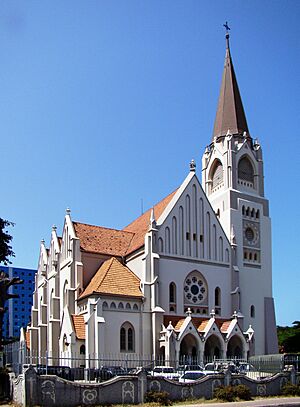
The city has many churches and mosques. Churches belong to different Christian groups, such as the Roman Catholic Archdiocese of Dar es Salaam (Catholic Church), Anglican Church of Tanzania (Anglican Communion), and Evangelical Lutheran Church in Tanzania (Lutheran World Federation). There are also Hindu temples. About 70% of the people in Dar es Salaam are Muslims.
Sports in Dar es Salaam
Stadiums
Dar es Salaam is the sports center of Tanzania. It has the second-largest stadium in East and Central Africa, the National Stadium, which can hold up to 60,000 people.
Football (Soccer)
The Tanzanian National Stadium is home to football clubs from Dar es Salaam, like Young Africans and Simba. It also hosts other Tanzanian football clubs and international matches.
Besides the National Stadium, the city has two other stadiums: the Uhuru Stadium and the Karume Memorial Stadium. The Uhuru Stadium is used for local tournaments and events. The Karume Memorial Stadium is home to the Tanzania Football Federation. Azam Complex Chamazi is owned by Azam Football Club.
Golf
The Gymkhana Golf Courses are located near the city center, overlooking the Indian Ocean. They also have tennis courts, squash courts, and a fitness club. Outside the main city areas, there is the Lugalo Military Golf Course.
Acrobatics
Mama Africa is a school founded in 2003. It is known for training some of Africa's best professional acrobats.
Boxing
Boxing is a popular sport in Tanzania. Dar es Salaam hosts many boxing events throughout the year. Tanzanian professional boxer Francis Checka is a well-known champion.
Media in Dar es Salaam
Newspapers
Newspapers in Dar es Salaam are often sold by vendors at busy road intersections. English newspapers include The Citizen and The Guardian. Swahili newspapers like Tanzania Daima and Mwananchi are also available. Business Times is the only financial newspaper in the city.
Television Stations
Dar es Salaam is home to several TV stations, including ITV, Sibuka, Channel Ten Television Station, and Azam TV (a subscription service). Ayo TV and the Tanzania Broadcasting Corporation are also based in Ubungo, Dar es Salaam.
Internet Access
The installation of the SEACOM cable in 2009 has made Internet access more available in Dar es Salaam and East Africa. While mobile Internet via 4G can be expensive, 5G is becoming available in major cities.
Radio
Dar es Salaam's first radio station started in the early 1950s.
Environment and Flooding
Since the 1990s, Dar es Salaam has experienced frequent and heavy flooding when there is intense rainfall. The city is especially vulnerable to floods because it is on a low-lying coast and the Msimbazi River flows through it. This problem has gotten worse over the years due to climate change and more paved areas in the city, which cause more water to run off.
Flooding can destroy bridges and roads, disrupt transportation, and increase the risk of diseases like cholera. It also makes it harder to reduce poverty in the city.
Education in Dar es Salaam
Dar es Salaam has many educational opportunities and is home to several universities.
Universities
- The University of Dar es Salaam is the oldest and second-largest public university in Tanzania. It is located in the western part of the city, about 13 kilometres (8 mi) from the city center. It has many undergraduate and postgraduate students.
- Ardhi University (ARU) started in 1996. It used to be a college of the University of Dar es Salaam. This university offers degrees in various subjects, including land surveying and architecture.
- The Muhimbili University of Health and Allied Sciences has two campuses. One is in Upanga, and the other is outside Dar es Salaam.
- The Open University of Tanzania is a public university that offers certificates, diplomas, and degrees. It has students from many countries.
- Hubert Kairuki Memorial University is a private university located in the Mikocheni area.
- International Medical and Technological University is another private university.
- Kampala International University started in 2009. Its center is located in the Gongo la Mboto area.
Notable People from Dar es Salaam
- Sir David Frank Adjaye (born 1966), a famous architect from London who was born in Dar es Salaam.
- Roald Dahl (1916–1990), a British novelist and poet who lived in Dar es Salaam from 1934 to 1939.
- Jane Goodall (born 1934), a famous scientist who studies animals, especially chimpanzees.
- Marin Hinkle (born 1966), an actress known for the TV show Two and a Half Men.
- Rachel Luttrell (born 1971), an actress known for Stargate Atlantis, born in Dar es Salaam.
- Mbwana Samatta (born 1992), a footballer who has played for the Tanzania national team.
- Hasheem Thabeet (born 1987), a basketball player who has played in the US.
Sister Cities
Dar es Salaam is connected to other cities around the world as "sister cities":
Images for kids
-
Saint Joseph's Metropolitan Cathedral. Christianity is the largest religion in Tanzania.
See also
 In Spanish: Dar es-Salam para niños
In Spanish: Dar es-Salam para niños


